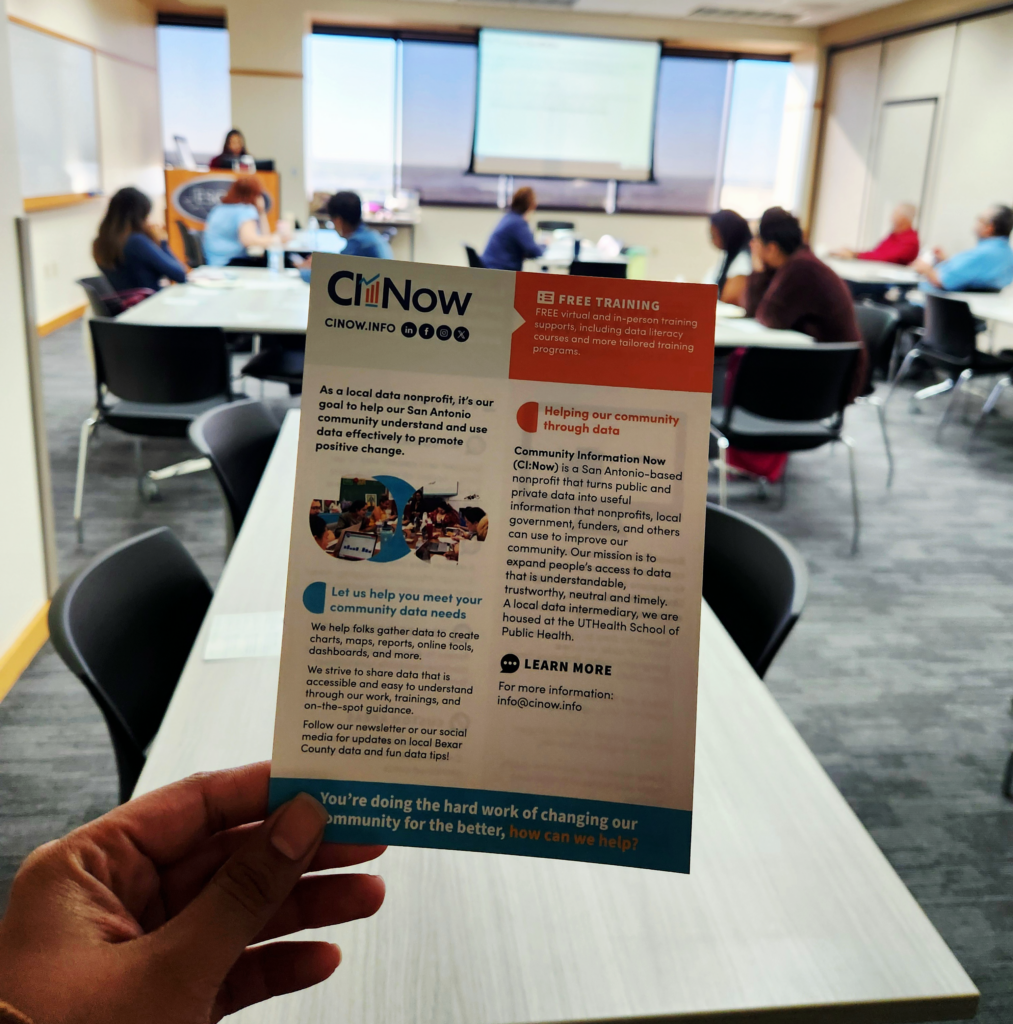What’s the news?
Community Information Now (CI:Now), a San Antonio-based nonprofit local data intermediary, has won a highly-competitive grant from the U.S. Department of Health and Human Services Office of Minority Health to help people in Bexar County access and use data to reduce health disparities and inequities.
One of just two awards made nationwide, the three-year grant with a Year 1 award of $250,000 will allow CI:Now and its partners to integrate data on health outcomes with sub-county data on social determinants of health like income, education, and housing. The grant will support the design of an online data portal that makes it easy for both beginner and advanced data users to access the data. The grant also supports outreach, training, and technical assistance to help people understand and use the data.
Who’s involved?
- CI:Now, the applicant, is a nonprofit local data intermediary that provides data, tools, analysis, and training to inform decisions to improve Texas communities, focusing primarily on Bexar and surrounding counties. Since 2008 CI:Now has contracted its core staffing through a powerful community-academic partnership with the University of Texas Health Science Center at Houston (UTHealth Houston) School of Public Health in San Antonio.
- The Health Collaborative is a powerful and robust network of citizens, community organizations, businesses, and health care providers working together to improve the health status of the community. THC is responsible for the comprehensive local community health needs assessment and the community health improvement planning process.
- Healthcare Access San Antonio (HASA) is the local nonprofit health information exchange (HIE) serving south-central Texas. Securely linking patient-level health data across area health care providers, labs, and pharmacies, HASA offers value-based, patient-centered information services intended to improve the health status of individuals and the communities it serves.
- The San Antonio Metropolitan Health District (Metro Health) is the public health agency charged by State law, City code, and County resolution with the responsibility for public health programs in San Antonio and unincorporated areas of Bexar County. Although it is a City/County organization, Metro Health is operated as a City of San Antonio department.
- The City of San Antonio Information Technology Services Department (COSA ITSD) is the centralized office that provides technology direction and oversight for the all of the City’s services and departments. COSA ITSD provides secure, reliable and responsive enterprise-level technology and business solutions that facilitate and enhance the City’s effectiveness in serving the citizens of San Antonio and align with the City’s goals.
- Data Driven Detroit (D3). D3, like CI:Now a partner in the National Neighborhood Indicators Partnership (NNIP), is the local data intermediary in Detroit, Michigan and a national leader in the field. D3 will provide consultation and technical assistance in user-centered design of the data platform.
How does data help?
San Antonio and Bexar County, Texas shoulder stark racial/ethnic health disparities underpinned largely by inequities in social determinants of health (SDOH). Bexar County has a majority-minority (72%) population whose demographic trends are widely accepted as foretelling national demographic shifts.
While data alone cannot solve any problem, local government, philanthropy, health and human service providers, grassroots advocacy and mutual help organizations, the faith community, and others need good data that shines a light on what those disparities are, what people and neighborhoods shoulder the greatest burden, the disparity severity and trend, and contributing factors, which may vary in nature and degree among different people and neighborhoods. Further, good data can expose important disparities by sex, age group, and income level within any racial/ethnic group. It can identify issue intersections that call for stronger cross-sector collaboration and systems change.
Why this project?
In 2016 CI:Now developed a framework called What’s Needed for a Community to be Good at Using Data? That framework identifies seven conditions that must be widespread for a community to use data effectively:
- A culture of valuing data;
- Data literacy;
- Processes and structures to support data use and communication;
- Good data management practices;
- Access to data;
- Access to help in using data effectively; and
- Collaborative and continual planning and action to build local capacity to use data.
Although no single project can by itself establish strong community data capacity, it can shore up weaknesses and build on existing strengths. While a wealth of data is available online, it is usually not broken down in ways that make it powerful and practical. Even assuming data access, the San Antonio-area community is held back by three factors that can be tackled through the project: low data literacy, lack of processes and structures to support data use and communication, and lack of help in using data.
What difference will it make?
The project will produce four concrete and measurable results that will directly support work to reduce and eliminate health disparities and inequities.
- Better disaggregation by race/ethnicity and place. The San Antonio metro area is consistently identified as one of the most highly economically-segregated in the country, but racial/ethnic segregation is much less pronounced. In many communities, high racial segregation means that geography can often be used as a proxy for race/ethnicity, but that method fails in San Antonio and Bexar County. Many disparities and inequities remain hidden unless data can be sliced by both race/ethnicity and place – we need much better information than just a county average. Unfortunately, data “sliced” at the census tract level or lower falls apart due to wide margins of error in survey estimates, data suppression to protect privacy, and volatile rates. Larger ZIP codes are commonly used but meaningless in most cases. To help solve that problem, with community input this project will develop super-neighborhoods based on census tracts that better reflect real neighborhoods than ZIP codes do.
- Better data integration. While CI:Now holds a tremendous amount of data, some published via online data tools and some through reports commissioned by partners, that data is not integrated and cannot be accessed using a single tool. There is currently no way for someone to find and acquire whatever local data is available for a specific neighborhood or for a specific population group.
- Better ease of access. The project will maximize access to the data holdings for both entry-level and advanced users. By creating two site “front doors” developed through user-centered design processes, CI:Now will help ensure that users of all skill levels have easy data access.
- Better supports for data access and use. CI:Now will develop training and supports for using the platform itself, data literacy training to help people understand data, and more tailored supports to help people think about how to apply data to decrease health disparities and SDOH inequities.
What about data privacy?
CI:Now intends to link highly-disaggregated datasets. “Highly-disaggregated” means that individual records are combined into groups. Those groupings are most often geographic (e.g., census tract, super-neighborhood, ZCTA) or demographic (e.g., race/ethnicity group, age group, sex). For example, individual hospital records are transformed into a rate of hospitalizations per 10,000 people for a given diagnosis by ZIP code, race/ethnicity, and age group. Individual student records are transformed into a four-year graduation rate by sex, race/ethnicity, and campus.
While several of those grouping fields like ZIP code qualify as Protected Health Information (PHI) under federal and/or state law, aggregation with automated suppression rules – for example, no data is shown for a grouping that has fewer than 10 records – greatly reduces the sensitivity of the data being handled. Using highly-disaggregated datasets rather than data about individual people or households meets most community needs while minimizing the risk of a privacy breach by handling as little private data as possible.
How can I keep up with project progress?
- For updates on the user-centered design process, platform development (launch tentatively set for September 2022), datasets available, Requests for Proposals to work on the project, and other progress updates, subscribe to our newsletter.
- To learn about opportunities to bid on contracts for web development, web design, and graphic design and other communications services, visit our Request for Proposals page.
- Visit the project progress dashboard to see how progress stacks up against our evaluation measures and targets. (As the project just began in October, as of November 2021 there’s not yet much to report.)
Whom do I contact for more information right now?
The easiest way to contact us is through our webform.

